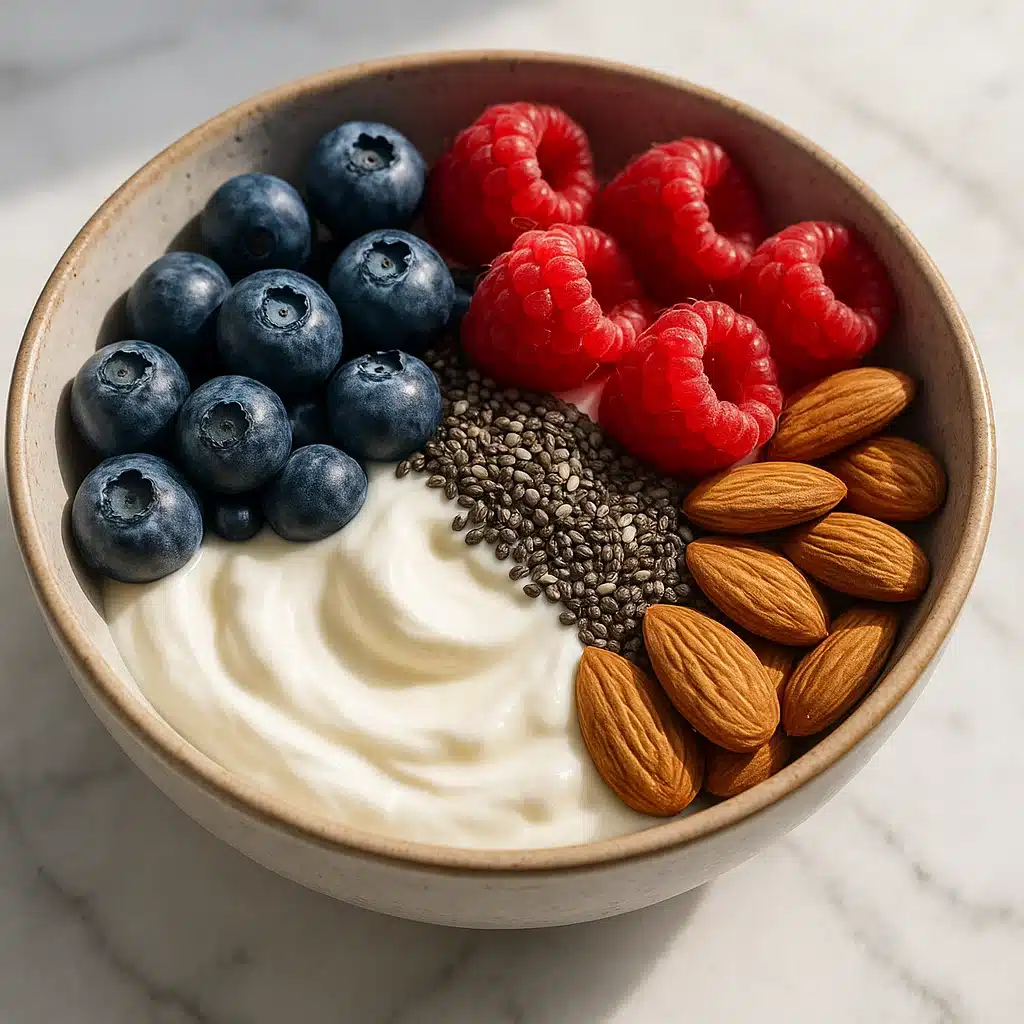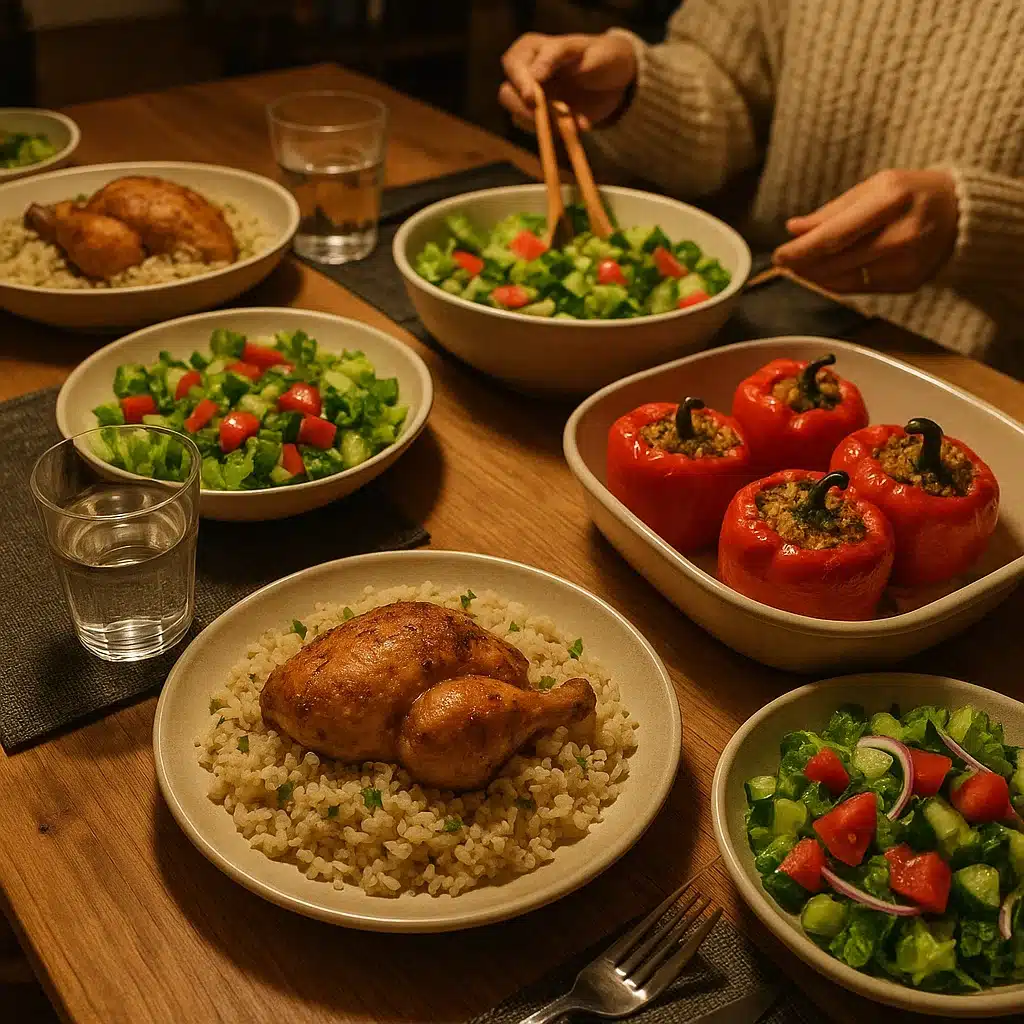If you’re searching for a fast, no-fuss dinner that’s both wholesome and delicious, Sheet Pan Sausage and Veggies is the answer. Packed with roasted vegetables, lean sausage, and bold seasonings, this easy one-pan meal is a time-saving lifesaver for busy weeknights or weekend meal prep.
Whether you’re feeding picky eaters, cleaning out your veggie drawer, or sticking to a clean eating plan, this dish delivers hearty, balanced nutrition—and you’ll only have one pan to clean.
Craving another easy one-dish winner? Don’t miss our Roasted Veggie Couscous Bowl—perfect for lunchboxes and light dinners.
Print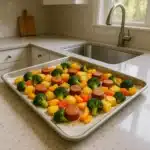
Sheet Pan Sausage and Veggies – A Quick, Healthy, One-Pan Meal Everyone Will Love
- Prep Time: 10 minutes
- Cook Time: 30 minutes
- Total Time: 40 minutes
- Yield: 4 1x
- Category: Dinner / Meal Prep
- Cuisine: American
Description
This Sheet Pan Sausage and Veggies recipe is a quick, flavorful, and healthy one-pan dinner perfect for busy weeknights or meal prep. Packed with roasted potatoes, crisp-tender veggies, and juicy chicken or turkey sausage, it’s tossed in olive oil and bold herbs for a balanced, protein-rich meal. Ready in just 40 minutes, it’s gluten-free, customizable, and family-approved!
Ingredients
2 cups baby red potatoes, diced small
3 cups green beans, trimmed and halved
2 cups broccoli florets (from 1 large head)
1½ cups bell peppers, chopped (2 large or 6 mini)
13 oz chicken or turkey smoked sausage, sliced ½” thick
6 tbsp olive oil
1 tsp paprika
½ tsp garlic powder
1 tbsp dried oregano
1 tbsp dried parsley
¼ tsp red pepper flakes (optional)
Salt and pepper to taste
Optional: Cooked quinoa or rice, Parmesan, fresh parsley
Instructions
-
Preheat oven to 400°F. Line a large sheet pan with parchment paper.
-
Prep all veggies and sausage. Dice potatoes small, cut beans and peppers, break broccoli into florets, and slice sausage into thick coins.
-
Combine ingredients on the sheet pan. Drizzle with olive oil and add all seasonings. Toss thoroughly to coat everything evenly.
-
Spread evenly on the pan, leaving space between pieces.
-
Bake for 15 minutes, remove to stir, then bake another 10–15 minutes until veggies are tender and sausage is browned.
-
Top with Parmesan or parsley if desired. Serve warm as is, or over quinoa or rice.
Notes
Use cauliflower or sweet potatoes as swaps.
Don’t overcrowd the pan—use two if needed.
Add mushrooms or zucchini halfway through roasting.
Reheats well for meal prep and leftovers.
Nutrition
- Serving Size: 4
- Calories: 430
- Sugar: 4g
- Sodium: 640mg
- Fat: 24g
- Carbohydrates: 25g
- Fiber: 5g
- Protein: 22g
Table of Contents
Table of Contents
Why Sheet Pan Sausage and Veggies Is a Go-To Weeknight Dinner
The Benefits of One-Pan Meals for Busy Families
When time is short and appetites are big, sheet pan meals are the hero of any kitchen. This dish simplifies dinnertime in every way:
- Minimal cleanup: Just one pan to wash
- Fast prep: No complex steps—chop, season, roast
- Hands-off cooking: Let the oven do the work
- Balanced nutrition: Protein + fiber-rich veggies + healthy fats
- Perfect for meal prep: Store well and reheat beautifully
For families, this kind of meal is not just convenient—it’s smart. With customizable ingredients and make-ahead potential, Sheet Pan Sausage and Veggies makes it easier to eat well, even when life gets hectic.
Flavor, Nutrition, and Zero Fuss
This recipe strikes the ideal balance between taste and health. You’ll enjoy:
- Crispy roasted veggies like green beans, red potatoes, bell peppers, and broccoli
- Savory, sliced chicken sausage that caramelizes in the oven
- A bold blend of herbs and spices like paprika, garlic powder, and oregano
- Olive oil for heart-healthy richness and perfect roasting
Serve it over rice, quinoa, or enjoy as-is—it’s satisfying either way. And if you’re looking for a protein-packed vegetarian option, our Mediterranean Quinoa Stuffed Peppers offer the same ease with plant-based flair.
Ingredients Overview – What You’ll Need for This Sheet Pan Favorite
Making Sheet Pan Sausage and Veggies is all about keeping it simple without sacrificing flavor or nutrition. The beauty of this dish lies in how basic ingredients come together into something bold, colorful, and crave-worthy.
Essential Ingredients
Here’s exactly what you’ll need to make a full sheet pan meal that serves 4 to 6 hungry eaters:
- 2 cups diced baby red potatoes – Choose small, evenly sized pieces for quick roasting.
- 3 cups green beans – Trimmed and halved for crisp-tender bites.
- 1 large head of broccoli (about 2 cups) – Broken into uniform florets.
- 1½ cups chopped bell peppers – Use colorful sweet peppers or standard red/yellow ones.
- 13 oz smoked sausage – Choose a lean, fully cooked variety like chicken or turkey sausage.
- 6 tablespoons olive oil – Helps caramelize veggies and crisp up the sausage.
- 1 tsp paprika + ½ tsp garlic powder – Flavor boosters that add depth and warmth.
- 1 tbsp dried oregano + 1 tbsp dried parsley – Earthy, herbal notes to round out the seasoning.
- ¼ tsp red pepper flakes (optional) – Add heat if desired.
- Salt and pepper to taste
Serving Option: Serve over cooked quinoa or brown rice to make it extra filling and add fiber.
Want more ways to use nutritious roasted veggies? Our Lemon Herb Baked Cod pairs beautifully with leftovers for another quick dinner idea.
Ingredient Tips and Substitutions
| Original Ingredient | Alternative Option |
|---|---|
| Baby red potatoes | Sweet potatoes or butternut squash cubes |
| Chicken sausage | Turkey sausage or tofu sausage (for vegetarian) |
| Olive oil | Avocado oil or light sesame oil |
| Broccoli | Cauliflower or Brussels sprouts |
Choose ingredients based on what’s in season or what’s already in your fridge. That’s the beauty of a dish like Sheet Pan Sausage and Veggies—it’s flexible, forgiving, and foolproof.
Step-by-Step Guide – How to Cook Sausage and Vegetables in the Oven
Making Sheet Pan Sausage and Veggies is as simple as chop, season, roast—and eat! This is one of those recipes where the oven does all the heavy lifting. Below is your foolproof guide to getting crispy, caramelized veggies and perfectly browned sausage every time.
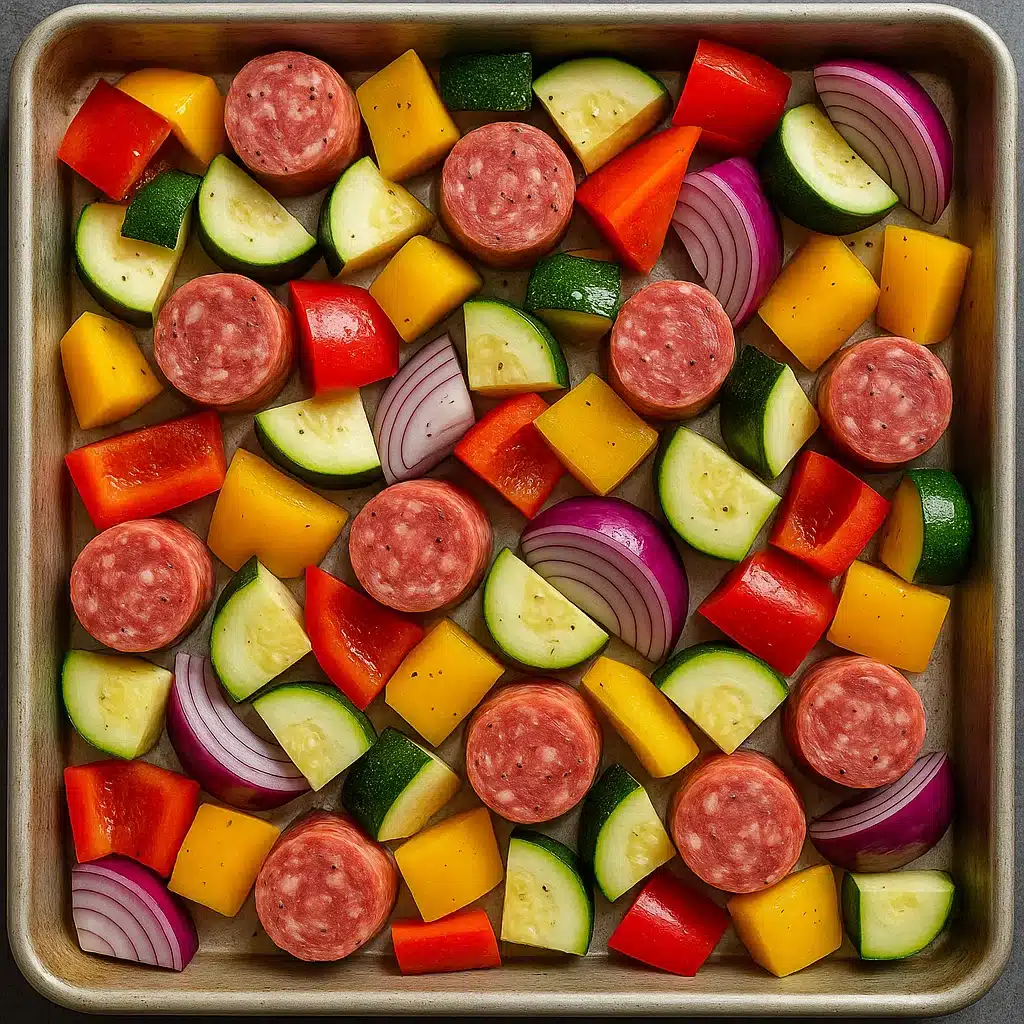
Step-by-Step Instructions
Step 1: Preheat the oven
Set your oven to 400°F (204°C) and line a large sheet pan (at least 15×21 inches) with parchment paper. If you’re using two smaller pans, divide the ingredients to avoid overcrowding.
Step 2: Prep the vegetables and sausage
Chop all ingredients to similar sizes so they cook evenly:
- Dice baby red potatoes into small chunks (10–12 pieces per potato)
- Halve and trim green beans
- Cut broccoli into bite-size florets
- Slice bell peppers into 1-inch pieces
- Slice sausage into ½-inch thick coins
Step 3: Combine and season
Spread the chopped veggies and sausage across your sheet pan. Drizzle with olive oil and sprinkle with paprika, garlic powder, dried oregano, parsley, red pepper flakes (optional), salt, and pepper. Use your hands or a spatula to toss everything until evenly coated.
Step 4: Roast and flip
Bake for 15 minutes, remove the pan, and use a spatula to toss and flip the veggies and sausage. Return to the oven for another 10–15 minutes or until potatoes are tender and veggies are golden at the edges.
Optional Finishing Touch:
Sprinkle with fresh parsley or grated Parmesan cheese right out of the oven for an extra flavor boost.
Pro Tips for Perfect Sheet Pan Sausage and Veggies
- Don’t overcrowd the pan: Overlapping ingredients will steam instead of roast.
- Cut ingredients uniformly: This ensures even cooking.
- Flip halfway through: Helps brown both sides evenly.
- Add soft vegetables later: If using zucchini or mushrooms, add them during the second half of cooking to prevent mushiness.
Want a cozy, veggie-forward dinner idea that also works for batch prep? Don’t miss our Savory Oatmeal Bowl with Egg & Avocado—it’s unexpected and delicious!
Best Seasoning for Sheet Pan Sausage and Vegetables
One of the easiest ways to turn Sheet Pan Sausage and Veggies into a flavor-packed dinner is through the right blend of herbs and spices. Roasting brings out natural sweetness in veggies and enhances the savory, smoky notes in sausage—but seasoning ties it all together.
Go-To Seasoning Blend for Sheet Pan Sausage and Veggies Dinners
Here’s the seasoning combo we recommend for bold, balanced flavor:
- 1 tsp paprika – Adds subtle warmth and color
- ½ tsp garlic powder – Brings savory depth
- 1 tbsp dried oregano – Mediterranean earthiness
- 1 tbsp dried parsley – Fresh herbal finish
- ¼ tsp red pepper flakes (optional) – For heat lovers
- Salt and pepper to taste
This blend complements the smoky flavor of sausage and the natural sweetness of bell peppers and red potatoes, making every bite vibrant and well-rounded.
Flavor Variations You Can Try
Want to switch things up without changing the whole recipe? Try these fun seasoning themes:
| Flavor Theme | Try Adding |
|---|---|
| Italian-Inspired | Basil, thyme, a splash of balsamic after roasting |
| Smoky Southwest | Cumin, chili powder, smoked paprika |
| Lemon Herb | Lemon zest, rosemary, extra parsley |
| Curry Roasted | Curry powder, turmeric, a dash of cayenne |
These variations keep Sheet Pan Sausage and Veggies exciting and allow you to match flavors with what you’re serving on the side—like couscous, quinoa, or even a dip.
Looking for another dish that uses a bold spice blend? Try our Mediterranean Quinoa Stuffed Peppers—a great companion meal for any weeknight.
What Vegetables Pair Well with Sausage? A Guide to Perfect Combos
When it comes to building the perfect Sheet Pan Sausage and Veggies meal, choosing the right vegetables makes all the difference. You want options that roast well, absorb flavor, and balance the richness of the sausage.
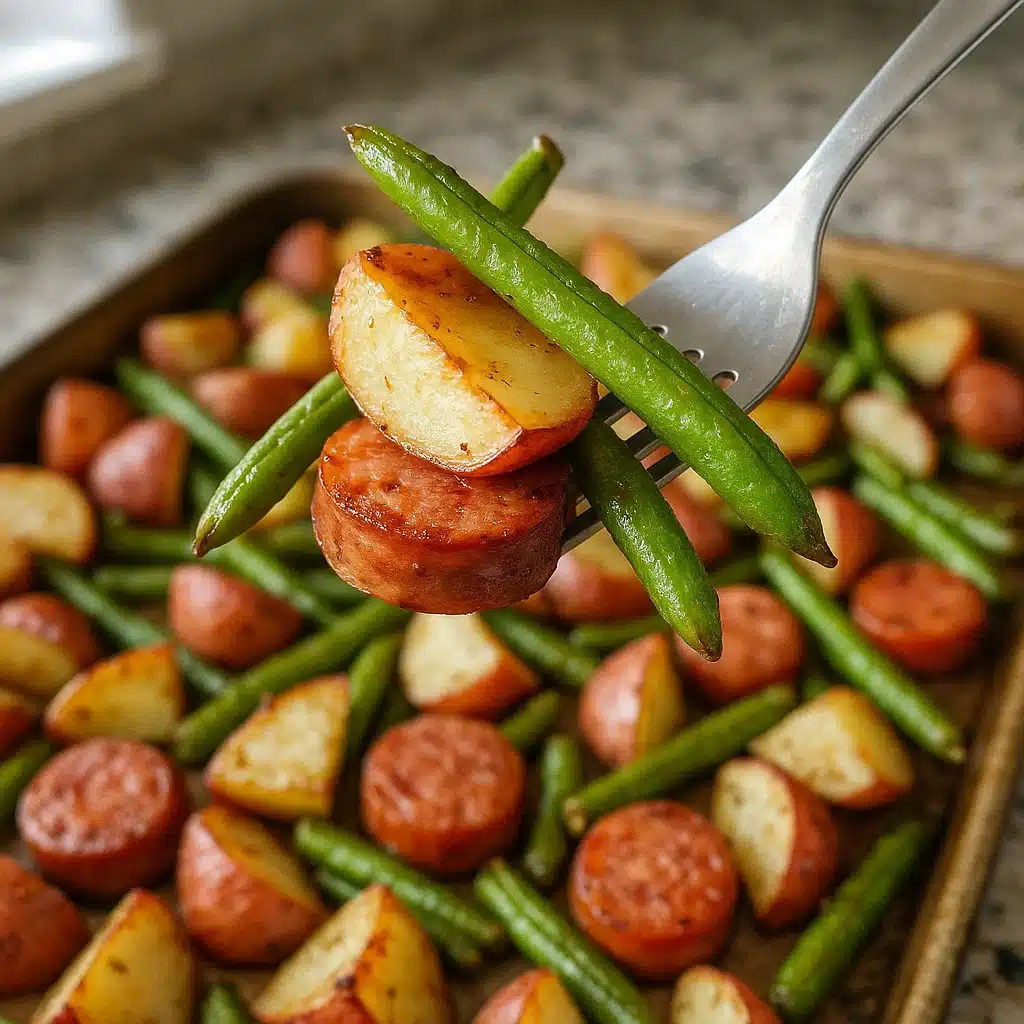
Best Vegetables for Roasting with Sausage
These veggies hold up to high heat and pair beautifully with the savory, smoky flavor of sausage:
- Baby red potatoes – Starchy and crispy when roasted
- Broccoli – Adds earthy flavor and crunch
- Green beans – Quick to cook and slightly sweet
- Bell peppers – Provide color, natural sweetness, and a soft texture
- Cauliflower – Roasts up nutty and tender
- Brussels sprouts – Crispy outside, soft inside when halved
- Carrots – Add sweetness and caramelize beautifully
These veggies roast in similar timeframes and deliver a balanced combination of textures and flavors.
Tips for Pairing Veggies with Sausage
| Roasting Tip | Why It Matters |
|---|---|
| Chop all veggies to similar sizes | Promotes even cooking and browning |
| Group softer veggies (like zucchini) apart | Add in last 10 minutes to prevent mushiness |
| Use colorful varieties (red, yellow peppers) | Enhances both nutrition and presentation |
| Use hearty roots like potatoes sparingly | They take longer—dice them small |
These small steps ensure your Sheet Pan Sausage and Veggies doesn’t just taste great—it looks and feels satisfying too.
Want a plant-based pairing idea? Our Roasted Veggie Couscous Bowl offers endless mix-and-match possibilities with these same veggies.
Can You Cook Vegetables with Raw Sausage? Safety & Flavor Tips
If you’re wondering whether you can roast raw sausage with your vegetables on the same pan, the answer is yes—but it’s important to follow a few guidelines to keep your Sheet Pan Sausage and Veggies both safe and flavorful.
Is It Safe to Roast Raw Sausage with Vegetables?
Absolutely—cooking raw sausage with vegetables is completely safe, as long as you ensure the sausage reaches the proper internal temperature. In most Sheet Pan Sausage and Veggies recipes, poultry sausage (like chicken or turkey) should hit 165°F (74°C), while beef or lamb sausages should reach 160°F (71°C).
Use a digital meat thermometer to confirm, or slice a coin to check that there’s no pink left inside and the juices run clear.
How to Cook Raw Sausage and Veggies Together on One Pan
When preparing Sheet Pan Sausage and Veggies with uncooked sausage, these tips help you achieve perfect results:
- Slice sausage into ½-inch coins – This speeds up cooking and ensures even heat.
- Toss everything in seasoning and oil – Helps the raw sausage flavor permeate the veggies.
- Space ingredients out – Avoid overlap to promote roasting rather than steaming.
- Roast at 400°F – This high heat is ideal for crisping sausage and caramelizing veggies.
- Flip halfway through roasting – Ensures even browning and prevents burning on one side.
By following these steps, your Sheet Pan Sausage and Veggies will come out sizzling, golden, and fully cooked in just 25–30 minutes.
Why Cooking Everything Together Enhances Flavor
One of the best reasons to make Sheet Pan Sausage and Veggies in a single roast is the flavor exchange. As the sausage cooks, it releases seasoned juices that coat the vegetables, creating a natural glaze full of savory, herbaceous notes. The veggies roast in these juices, deepening their flavor while keeping them juicy and crisp at the edges.
Need more inspiration for complete, oven-baked meals? Don’t miss our Sheet Pan Chicken Sausage and Vegetables—a delicious variation that’s also perfect for meal prep.
Serving Suggestions and Satisfying Sides
One of the best things about Sheet Pan Sausage and Veggies is its flexibility—it works great as a complete meal, but it also pairs beautifully with simple sides that elevate the entire dish. Whether you’re serving it family-style or meal prepping for the week, here are some tasty and balanced ways to round out your plate.
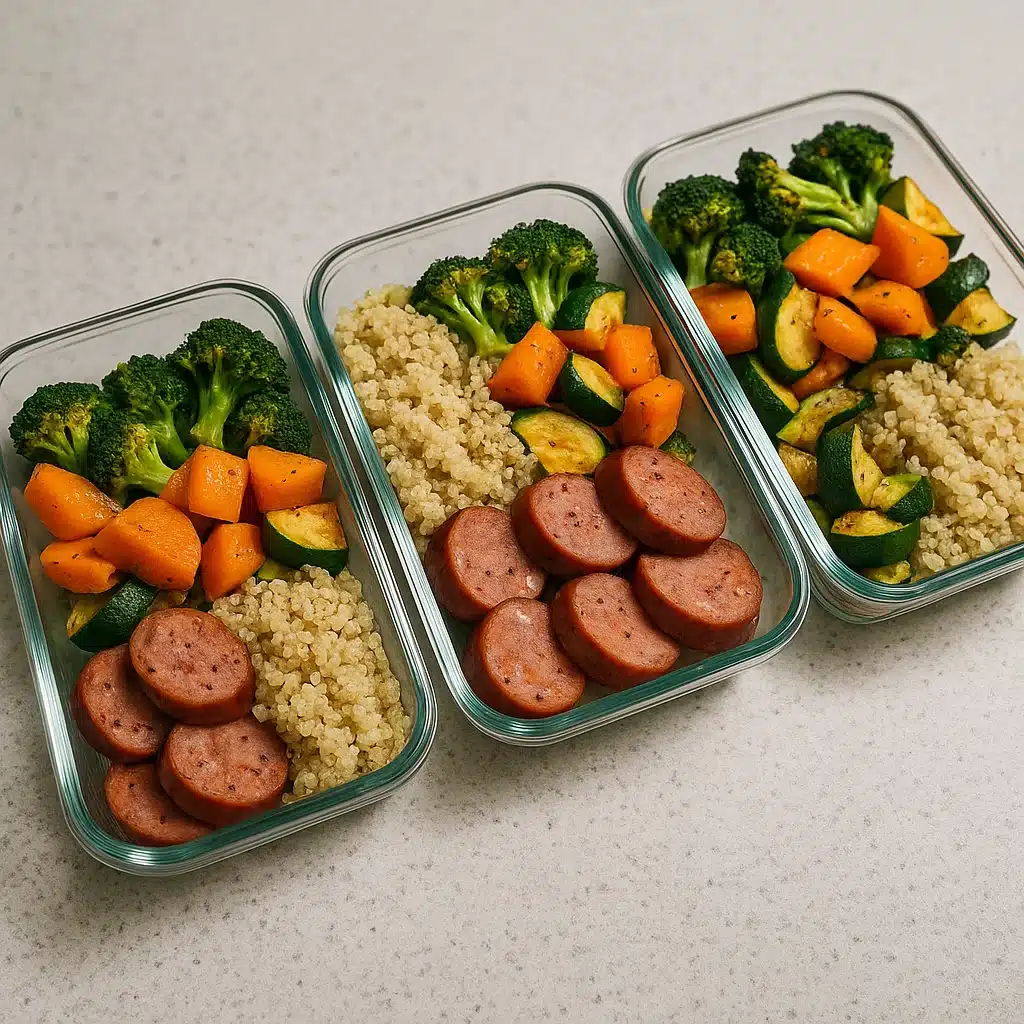
What to Serve with Sheet Pan Sausage and Veggies
You can enjoy Sheet Pan Sausage and Veggies on its own for a light, clean dinner—or build on it to create a more filling, complete meal.
Here are some of the best additions:
- Cooked quinoa or brown rice
Adds fiber, protein, and helps absorb the flavorful sausage juices. - Cauliflower rice or zucchini noodles
Great for a low-carb or keto-friendly base. - Whole wheat pita or naan
Serve the sausage and veggies inside flatbread for an easy wrap or pocket-style meal. - Fresh green salad
A crisp side with lemon vinaigrette balances the roasted richness of the dish. - Hummus or garlic yogurt sauce
Adds a creamy, Mediterranean touch to your plate.
Garnishes and Finishing Touches
Want to take your Sheet Pan Sausage and Veggies from basic to brilliant? Top it with:
- Freshly chopped parsley – Adds brightness and color
- A squeeze of lemon – Enhances the natural sweetness of roasted veggies
- Grated Parmesan cheese – Adds a nutty richness (optional but delicious)
These small touches go a long way in turning a simple Sheet Pan Sausage and Veggies dinner into a restaurant-worthy meal.
Looking for more flavor-packed sides? Try pairing with our Lemon Herb Baked Cod or enjoy it next to our Roasted Veggie Couscous Bowl for a colorful vegetarian spread.
Make It Your Own – Customizations, Swaps, and Meal Prep Tips
The beauty of Sheet Pan Sausage and Veggies is how easy it is to adapt. Whether you’re cooking for dietary needs, seasonal ingredients, or just personal preference, this dish bends to fit your lifestyle. It’s also a meal-prepper’s dream: easy to batch, store, and reheat.
Customize Your Ingredients
Here are some popular swaps and add-ins to make your Sheet Pan Sausage and Veggies unique every time:
| Original | Swap Option |
|---|---|
| Chicken sausage | Turkey, veggie, or tofu sausage |
| Red potatoes | Sweet potatoes, carrots, or butternut squash |
| Broccoli | Cauliflower or Brussels sprouts |
| Olive oil | Avocado oil or lemon-infused oil |
| Bell peppers | Zucchini, mushrooms, or cherry tomatoes |
You can also add:
- Corn kernels for sweetness
- Chickpeas for added plant protein
- Sliced onions for an extra savory layer
These swaps keep your Sheet Pan Sausage and Veggies exciting and easy to repeat without feeling repetitive.
Meal Prep & Storage Tips
Sheet Pan Sausage and Veggies is one of the best meals to prep ahead. Here’s how:
- Cool completely before storing
- Divide into airtight containers for lunchboxes or weekly dinners
- Store in fridge up to 4 days
- Reheat in the oven or air fryer to restore crispiness
For freezing:
- Portion the cooked sausage and veggies into freezer-safe bags
- Reheat in a hot oven or skillet for best texture (avoid microwave if possible)
Pair with cooked grains like quinoa or rice before freezing for a ready-to-go complete meal.
Need more easy-prep meal ideas? Check out our Savory Oatmeal Bowl with Egg & Avocado—a surprisingly satisfying make-ahead option.
Common Mistakes to Avoid When Making Sheet Pan Dinners
Even the simplest recipes can go sideways if a few basics are missed. When it comes to making Sheet Pan Sausage and Veggies, these common mistakes could mean the difference between crisp-tender deliciousness and a soggy, bland dinner.
Here’s what to avoid—and how to get it right every time.
1. Overcrowding the Sheet Pan
The #1 issue with Sheet Pan Sausage and Veggies? Trying to fit everything on one crowded tray.
What happens: Veggies steam instead of roast, leading to mushy textures.
Fix it: Use a large pan (at least 15×21 inches), or split into two smaller pans. Give each piece breathing room.
2. Cutting Veggies Unevenly
Chopping vegetables in random sizes causes some pieces to burn while others undercook.
Fix it: Cut everything into similar-sized pieces. For example, dice potatoes small so they roast as quickly as bell peppers or green beans.
3. Skipping the Flip
Not stirring or flipping your Sheet Pan Sausage and Veggies halfway through roasting means one side overbrowns and the other stays pale.
Fix it: Use a spatula to gently turn everything after 15 minutes. This ensures caramelization on all sides.
4. Not Preheating the Oven
Throwing the pan into a cold oven delays roasting and makes the sausage greasy instead of crisp.
Fix it: Always preheat your oven to 400°F before roasting.
5. Using Unseasoned Oil or Not Enough Seasoning
Even quality veggies and sausage fall flat without flavor.
Fix it: Mix your olive oil with paprika, garlic powder, oregano, and parsley before tossing. Then season generously with salt and pepper.
Bonus Tip: Don’t Add Soft Veggies Too Early
Zucchini, mushrooms, and cherry tomatoes cook faster. Add them halfway through the baking time so they don’t overcook.
Want to skip the mistakes and try a foolproof flavor-packed version? Get started with our Sheet Pan Chicken Sausage and Vegetables—it’s a delicious variation that delivers every time.
Frequently Asked Questions (FAQ)
What seasoning to put on sheet pan sausage and vegetables?
Paprika, garlic powder, oregano, parsley, salt, and pepper are perfect. Add red pepper flakes if you like heat, and finish with lemon juice or Parmesan for extra flavor.
How to cook sausage and vegetables in the oven?
Preheat to 400°F, chop everything evenly, toss with oil and seasoning, roast for 15 minutes, stir, and roast 10–15 minutes more until sausage is browned and veggies are crisp-tender.
What vegetables pair well with sausage?
Red potatoes, broccoli, green beans, bell peppers, Brussels sprouts, cauliflower, and carrots are top picks. They balance the savory richness of sausage and roast beautifully.
Can you cook vegetables with raw sausage?
Yes, just ensure sausage reaches 165°F. Slice sausage into ½-inch coins and roast with the veggies, flipping halfway to cook evenly and safely.
Conclusion
Whether you need a quick weeknight meal, a protein-packed lunch prep, or a colorful way to clean out your fridge, Sheet Pan Sausage and Veggies is your answer. With minimal effort and bold flavor, it’s a recipe you’ll make again and again.
Looking for another flavor-packed tray bake? Try our Mediterranean Quinoa Stuffed Peppers—loaded with fiber, color, and plant-powered protein.
Let’s Stay Connected for More Easy Recipes!
Love this recipe? You’ll find even more quick, wholesome meals just like this on our social channels! Follow us on Facebook for daily kitchen tips, new recipe drops, and smart meal prep ideas. For beautiful step-by-step visuals and easy-to-save inspiration boards, head over to our Pinterest page. Join our growing community of food lovers and never run out of healthy, flavorful meal ideas again!

